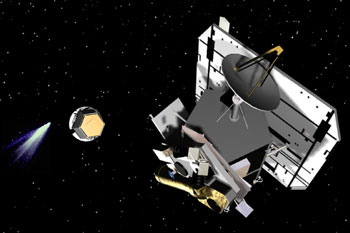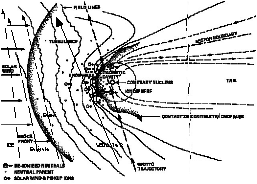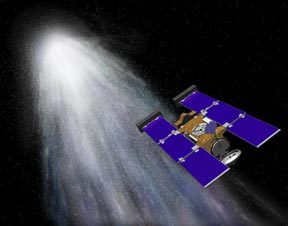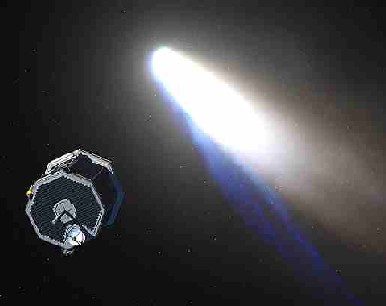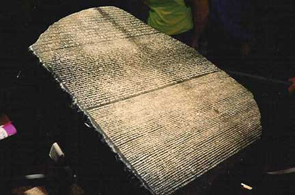Comet Missions
| Mission | Country/Agency | Launch Date | Encounter Date | Comets Explored | Encounter Characteristics |
|---|---|---|---|---|---|
| Contour | USA/NASA | July 2002 | N/A | Comet Encke (2003) Comet Schwassmann-Wachmann-3 (2004) Comet d'Arrest (2008) |
The Comet Nucleus Tour (CONTOUR) was suppose to fly around these three comets. Unfortunately, contact with the spacecraft was lost less than a month into the mission. CONTOUR has not been heard from since then. |
| Deep Impact | USA/NASA | December 2004 | July 2005 | Comet Tempel 1 | When Deep Impact nears the comet Tempel 1, it will separate into two parts. One part will fly by the comet and record data. The second part is the "impactor"...it will crash into the comet nucleus so scientists can study the comet nucleus! |
| Deep Space 1 | USA/NASA | October 15, 1998 | September 2001 | Comet Borrelly | Deep Space 1 tested 12 new revolutionary technologies that will be used in future missions. It had a close encounter with comet Borrelly, and returned the best images ever from a comet. The spacecraft was retired in December 2001. |
| Galileo | USA/NASA | October 18, 1989 | July 1994 | Comet Shoemaker-Levy 9 | Galileo is not specifically a comet mission, but it was able to make the only direct observations of comet Shoemaker-Levy 9 as over 20 fragments of the comet plunged into Jupiter's nightside atmosphere over a six-day interval. |
| Giotto | European Space Agency | July 2, 1985 | March 13, 1986 July 10, 1992 |
Comet Halley (1986) Comet Grigg-Skjellerup (1992) |
Giotto took the first close-up images of a comet nucleus. It was also the first mission to encounter 2 comets. |
| ISEE-3/ICE | USA/NASA | August 12, 1978 | September 11, 1985 March 28, 1986 |
Comet Giacobini-Zinner (1985) Comet Halley (1986) |
First ever comet encounter with Giacobini-Zinner. Made distant observations of Halley. Will return to the vicinity of Earth in 2014 and could possibly be captured then. |
| Rosetta | European Space Agency | February 26, 2004 | November 2014 | Comet Churyumov-Gerasimenko | Rosetta missed its launch window in January 2003, but has been rescheduled for launch. This will still be the first mission to land an instrument package on a comet. |
| Sakigake | Japan | January 7, 1985 | March 11, 1986 | Comet Halley | First Japanese Deep Space Probe. Sakigake found that solar wind was affected by the presence of comet Halley. |
| SOHO | NASA/European Space Agency | December 2, 1995 | Throughout mission | Various comets | Although it is a solar observatory, this spacecraft has observed over a hundred "sun-grazer" comets. |
| Stardust | USA/NASA | February 7, 1999 | January 2004 | Comet Wild 2 | Its primary goal is to collect comet dust and volatile samples during a planned close encounter with comet Wild 2. It will then return the samples to Earth. |
| Suisei | Japan | August 18, 1985 | March 8, 1986 | Comet Halley | Second Japanese Deep Space Probe. Suisei means "comet" in Japanese. |
| Ulysses | NASA/ESA | October 6, 1990 | beginning in 1994 | many - see explanation | Ulysses is not specifically a comet mission, but it is used to make observations of comets, especially those within 2 A.U. of the Sun and 20 degrees of the spacecraft. A Ulysses Comet Watch Network was set up in 1992 and includes 250 observers around the world. Professional and amateur observers along with Ulysses have observed comets Borrelly, D'Arrest, Encke, Mueller, Pons-Winnecke, Temple 2, Tuttle, Hale-Bopp and others. |
| Vega 1 | USSR | December 15, 1984 | March 4, 1986 | Comet Halley | Worked in combination with Vega 2. Both spacecraft went first to Venus and then onto an encounter with comet Halley. Vega 1 was the first spacecraft to reach comet Halley. |
| Vega 2 | USSR | December 21, 1984 | March 9, 1986 | Comet Halley | Worked in combination with Vega 1. Vega 2 was the second spacecraft to reach comet Halley, but approached the comet at a closer distance than Vega 1. |
 An Overview of Space Exploration
An Overview of Space Exploration
Last modified January 12, 2004 by Jennifer Bergman.






